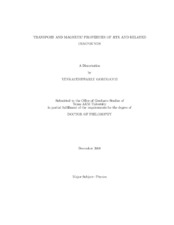| dc.description.abstract | Physical properties of RTX compounds (R = Rare earth, T = Transition metal and
X = main group element from B, C or N group) compounds have been studied by
means of electrical resistivity, heat capacity, dc magnetization and NMR. Searching
for new magnetic materials is always an interesting topic from both a technological and basic research prospective; it is even more interesting when unusual magnetic phases are observed. Ternary intermetallic plumbides are interesting because of
their unconventional magnetic ordering and variety of multiple magnetic transitions.
Crystalline electric fields (CEF) also strongly effect the magnetic properties of these
intermetallics. To understand the phase transitions, CEF effects, and magnetic interactions, a systematic study of the RNiPb, R2Ni2Pb, R5NiPb3 and RCuGe systems
were conducted.
Among the results for NdNiPb a single antiferromagnetic transition was found
at 3.5K, while the superconductivity found in some ingots of this material was shown
not to correspond to a bulk behavior for this phase. Nd2Ni2Pb was shown to have a
canted zero field magnetic structure with a low temperature metamagnetic transition
3 T. In NdCuGe, a 3K AF transition was found along with a corresponding magnon
contribution to the specific heat and magnetic and thermodynamic behavior from which the detailed CEF configuration was obtained.
In a series of measurements on recently-synthesized R5NiPb3 (R=Ce, Nd, Gd),
for Ce5NiPb3 a transition at 48 K was found, which was confirmed to be ferromagnetic character from field dependent heat capacity and Curie-Weiss susceptibility.
Nd5NiPb3 exhibits two transitions, an antiferromagnetic transition at 42 K and an
apparently weak ferromagnetic canting transition at 8 K. For Gd5NiPb3, a ferro- or
ferrimagnetic transition was found at 68 K. For the Ce and Nd materials metamagnetism was also observed at low temperatures. In addition, very large metallic type
y terms were found in the specific heat, as well as a reduced value of the magnetic
entropy, for all three systems. These results imply a lack of ordering for one of the
two in-equivalent chains in these materials. This is discussed in terms of possible
geometrical frustration on one of the spin chains. | en |


